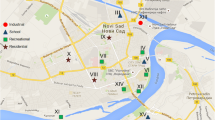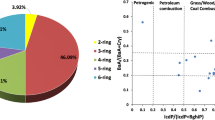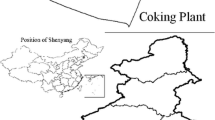Abstract
The role of preferential biodegradation in the reduction of cancer risk caused by polycyclic aromatic hydrocarbons (PAHs) has been studied. A consortium of microorganisms isolated from aged oil refinery exposed soil was used to degrade 13 PAHs content extracted from an urban traffic site soil. The biodegradation arranged in a batch process with a mineral salt broth, where PAHs were the sole carbon source. 70.46% biodegradation of the total PAHs occurred in an incubation period of 25 days. Sequential or preferential biodegradation took place as the lower molecular weight (LMW) PAHs were more prone to biodegradation than that of the higher molecular weight (HMW) PAHs. Microorganisms from the isolated consortia preferred the simpler carbon sources first. The relatively higher carcinogenicity of the HMW PAHs than that of the LMW PAHs leads to only 40.26% decrement in cancer risk. Initial cancer risk for children was 1.60E−05, which was decreased to 9.47E−06, whereas, for the adults, the risk decreased to 1.01E−05 from an initial value of 1.71E−05. The relative skin adherence factor for soil (AF) turned out to be the most influential parameter with 54.2% contributions to variance in total cancer risk followed by the exposure duration (ED) for children. For the adults, most contributions to the variance in total cancer risk were 58.5% by ED and followed by AF.





Similar content being viewed by others
References
Agarwal T, Khillare PS, Shridhar V (2006) PAHs contamination in bank sediment of the Yamuna River, Delhi, India. Environ Monit Assess 123:151–166. doi:10.1007/s10661-006-9189-6
Bonnet JL, Guiraud P, Dusser M et al (2005) Assessment of anthracene toxicity toward environmental eukaryotic microorganisms: Tetrahymena pyriformis and selected micromycetes. Ecotoxicol Environ Saf 60:87–100. doi:10.1016/j.ecoenv.2003.10.001
Buonanno G, Giovinco G, Morawska L, Stabile L (2015) Lung cancer risk of airborne particles for Italian population. Environ Res 142:443–451. doi:10.1016/j.envres.2015.07.019
Bushnell LD, Haas HF (1941) The utilization of certain hydrocarbons by microorganisms. J Bacteriol 41:653–673
Caricchia AM, Chiavarini S, Pezza M (1999) Polycyclic aromatic hydrocarbons in the urban atmospheric particulate matter in the city of Naples (Italy). Atmos Environ 33:3731–3738. doi:10.1016/S1352-2310(99)00199-5
Chen S-C, Liao C-M (2006) Health risk assessment on human exposed to environmental polycyclic aromatic hydrocarbons pollution sources. Sci Total Environ 366:112–123. doi:10.1016/j.scitotenv.2005.08.047
Chiang KC, Chio CP, Chiang YH, Liao CM (2009) Assessing hazardous risks of human exposure to temple airborne polycyclic aromatic hydrocarbons. J Hazard Mater 166:676–685. doi:10.1016/j.jhazmat.2008.11.084
Desai AM, Autenrieth RL, Dimitriou-Christidis P, McDonald TJ (2008) Biodegradation kinetics of select polycyclic aromatic hydrocarbon (PAH) mixtures by Sphingomonas paucimobilis EPA505. Biodegradation 19:223–233. doi:10.1007/s10532-007-9129-3
Giraud F, Guiraud P, Kadri M et al (2001) Biodegradation of anthracene and fluoranthene by fungi isolated from an experimental constructed wetland for wastewater treatment. Water Res 35:4126–4136. doi:10.1016/S0043-1354(01)00137-3
Gungormus E, Tuncel S, Hakan Tecer L, Sofuoglu SC (2014) Inhalation and dermal exposure to atmospheric polycyclic aromatic hydrocarbons and associated carcinogenic risks in a relatively small city. Ecotoxicol Environ Saf 108:106–113. doi:10.1016/j.ecoenv.2014.06.015
Haritash AK, Kaushik CP (2009) Biodegradation aspects of polycyclic aromatic hydrocarbons (PAHs): a review. J Hazard Mater 169:1–15. doi:10.1016/j.jhazmat.2009.03.137
Hoseini M, Yunesian M, Nabizadeh R et al (2015) Characterization and risk assessment of polycyclic aromatic hydrocarbons (PAHs) in urban atmospheric particulate of Tehran, Iran. Env Sci Pollut Res Int 23:23. doi:10.1007/s11356-015-5355-0
Juhasz AL, Naidu R (2000) Bioremediation of high molecular weight polycyclic aromatic hydrocarbons: a review of the microbial degradation of benzo[a]pyrene. Int Biodeterior Biodegradation 45:57–88. doi:10.1016/S0964-8305(00)00052-4
Krivobok S, Miriouchkine E, Seigle-Murandi F, Benoit-Guyod J-L (1998) Biodegradation of anthracene by soil fungi. Chemosphere 31:523–530
Li X, Li P, Lin X et al (2008) Biodegradation of aged polycyclic aromatic hydrocarbons (PAHs) by microbial consortia in soil and slurry phases. J Hazard Mater 150:21–26. doi:10.1016/j.jhazmat.2007.04.040
Li Z, Ma Z, van der Kuijp TJ et al (2014) A review of soil heavy metal pollution from mines in China: pollution and health risk assessment. Sci Total Environ 468–469:843–853. doi:10.1016/j.scitotenv.2013.08.090
Li J, Dong H, Li X et al (2016) Quantitatively assessing the health risk of exposure to PAHs from intake of smoked meats. Ecotoxicol Environ Saf 124:91–95. doi:10.1016/j.ecoenv.2015.10.007
Lundstedt S, Haglund P, Öberg L (2003) Degradation and formation of polycyclic aromatic compounds during bioslurry treatment of an aged gasworks soil. Environ Toxicol Chem 22:1413–1420. doi:10.1002/etc.5620220701
Man YB, Kang Y, Wang HS et al (2013) Cancer risk assessments of Hong Kong soils contaminated by polycyclic aromatic hydrocarbons. J Hazard Mater 261:770–776. doi:10.1016/j.jhazmat.2012.11.067
NYS DOH (2012) Health consultation: hopewell precision area groundwater contamination site town of East Fishkill, Dutchess County, New York. APPENDIX C, DOH Procedure for Evaluating Potential Health Risks for Contaminants of Concern. NewYork
Pan E, Sun H, Xu Q et al (2015) Polycyclic aromatic hydrocarbons concentrations in drinking water in villages along the Huai River in China and their association with high cancer incidence in local population. Biomed Res Int. doi:10.1155/2015/762832
Phale PS, Basu A, Majhi PD et al (2007) Metabolic diversity in bacterial degradation of aromatic compounds. OMICS 11:252–279. doi:10.1089/omi.2007.0004
Qu C, Li B, Wu H et al (2015) Multi-pathway assessment of human health risk posed by polycyclic aromatic hydrocarbons. Environ Geochem Health 37:587–601. doi:10.1007/s10653-014-9675-7
Ray S, Khillare PS, Agarwal T, Shridhar V (2008) Assessment of PAHs in soil around the international airport in Delhi, India. J Hazard Mater 156:9–16. doi:10.1016/j.jhazmat.2007.11.099
Samanta SK, Singh OV, Jain RK (2002) Polycyclic aromatic hydrocarbons: environmental pollution and bioremediation. Trends Biotechnol 20:243–248. doi:10.1016/S0167-7799(02)01943-1
Stringfellow WT, Aitken MD (1995) Competitive metabolism of naphthalene, methylnaphthalenes, and fluorene by phenanthrene-degrading pseudomonads. Appl Environ Microbiol 61:357–362
Suman S, Sinha A, Tarafdar A (2016) Polycyclic aromatic hydrocarbons (PAHs) concentration levels, pattern, source identification and soil toxicity assessment in urban traffic soil of Dhanbad, India. Sci Total Environ 545–546:353–360. doi:10.1016/j.scitotenv.2015.12.061
Tang L, Tang X-Y, Zhu Y-G et al (2005) Contamination of polycyclic aromatic hydrocarbons (PAHs) in urban soils in Beijing, China. Environ Int 31:822–828. doi:10.1016/j.envint.2005.05.031
Tiwari B, Manickam N, Kumari S, Tiwari A (2016) Biodegradation and dissolution of polyaromatic hydrocarbons by Stenotrophomonas sp. Bioresour Technol 216:1102–1105. doi:10.1016/j.biortech.2016.06.047
Trapido M (1999) Polycyclic aromatic hydrocarbons in Estonian soil: contamination and profiles. Environ Pollut 105:67–74. doi:10.1016/S0269-7491(98)00207-3
Tsai PJ, Shih TS, Chen HL et al (2004) Assessing and predicting the exposures of polycyclic aromatic hydrocarbons (PAHs) and their carcinogenic potencies from vehicle engine exhausts to highway toll station workers. Atmos Environ 38:333–343. doi:10.1016/j.atmosenv.2003.08.038
USEPA (1989) Risk assessment guidance for superfund. In: Volume I: Human Health Evaluation Manual (Part A). I, 291. U.S. Environmental Protection Agency, Washington, D.C. EPA/540/1-89/002
USEPA (1993) Provisional guidance for quantitative risk assessment of polycyclic aromatic hydrocarbons. U.S. Environmental Protection Agency, Washington, D.C. EPA/600/R-93/089
USEPA (1997) Exposure factors handbook. Volume 1: General Factors. U.S. Environmental Protection Agency I:1193, Washington, D.C. EPA/600/P-95/002F a-c
Wang C, Wang F, Wang T et al (2010) PAHs biodegradation potential of indigenous consortia from agricultural soil and contaminated soil in two-liquid-phase bioreactor (TLPB). J Hazard Mater 176:41–47. doi:10.1016/j.jhazmat.2009.10.123
Wang W, Huang M-J, Kang Y et al (2011) Polycyclic aromatic hydrocarbons (PAHs) in urban surface dust of Guangzhou, China: status, sources and human health risk assessment. Sci Total Environ 409:4519–4527. doi:10.1016/j.scitotenv.2011.07.030
Williams ES, Mahler BJ, Van Metre PC (2013) Cancer risk from incidental ingestion exposures to PAHs associated with coal-tar-sealed pavement. Environ Sci Technol 47:1101–1109. doi:10.1021/es303371t
Wilson MJ, Frickel S, Nguyen D et al (2014) A targeted health risk assessment following the deep water horizon oil spill: polycyclic aromatic hydrocarbon exposure in Vietnamese-American shrimp consumers. Environ Health Perspect 152:152–159. doi:10.1289/ehp.1408684
Wu B, Zhang Y, Zhang X-X, Cheng S-P (2011) Health risk assessment of polycyclic aromatic hydrocarbons in the source water and drinking water of China: quantitative analysis based on published monitoring data. Sci Total Environ 410–411:112–118. doi:10.1016/j.scitotenv.2011.09.046
Yang W, Lang Y, Li G (2014) Cancer risk of polycyclic aromatic hydrocarbons (PAHs) in the soils from Jiaozhou Bay wetland. Chemosphere 112:289–295. doi:10.1016/j.chemosphere.2014.04.074
Yu B, Xie X, Ma LQ et al (2014) Source, distribution, and health risk assessment of polycyclic aromatic hydrocarbons in urban street dust from Tianjin, China. Environ Sci Pollut Res Int 21:2817–2825. doi:10.1007/s11356-013-2190-z
Zhang S, Wan R, Wang Q, Xie S (2011) Identification of anthracene degraders in leachate-contaminated aquifer using stable isotope probing. Int Biodeterior Biodegrad 65:1224–1228. doi:10.1016/j.ibiod.2011.10.002
Zhou B, Zhao B (2012) Population inhalation exposure to polycyclic aromatic hydrocarbons and associated lung cancer risk in Beijing region: contributions of indoor and outdoor sources and exposures. Atmos Environ 62:472–480. doi:10.1016/j.atmosenv.2012.08.059
Zhou B, Zhao B (2014) Analysis of intervention strategies for inhalation exposure to polycyclic aromatic hydrocarbons and associated lung cancer risk based on a Monte Carlo population exposure assessment model. PLoS One. doi:10.1371/journal.pone.0085676
Acknowledgements
Authors acknowledge Technical Education Quality Improvement Program-Phase II (TEQIP II), IIT (ISM), Dhanbad, for providing financial assistance for successful completion of this study.
Author information
Authors and Affiliations
Corresponding author
Additional information
Responsible editor: Philippe Garrigues
Electronic supplementary material
ESM 1
(DOCX 27 kb)
Rights and permissions
About this article
Cite this article
Tarafdar, A., Sinha, A. Estimation of decrease in cancer risk by biodegradation of PAHs content from an urban traffic soil. Environ Sci Pollut Res 24, 10373–10380 (2017). https://doi.org/10.1007/s11356-017-8676-3
Received:
Accepted:
Published:
Issue Date:
DOI: https://doi.org/10.1007/s11356-017-8676-3




